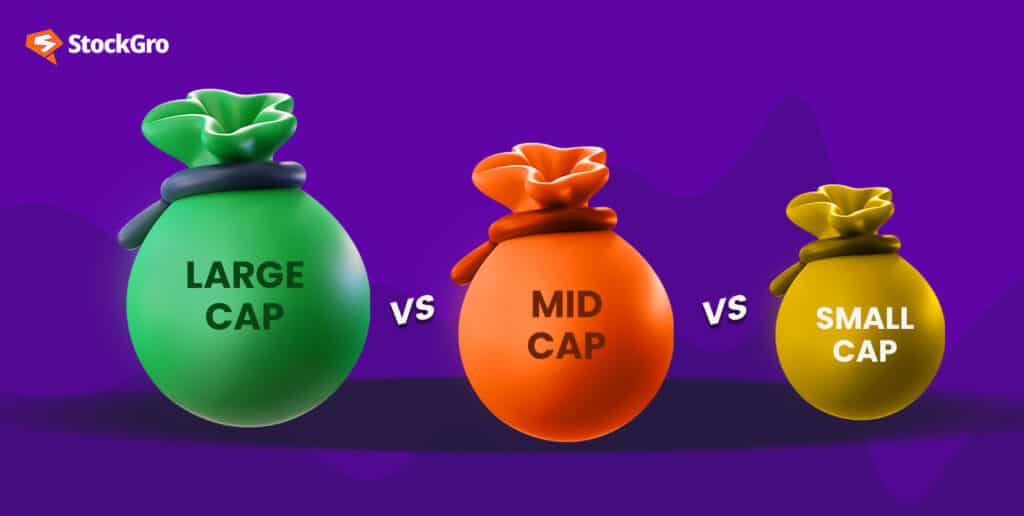
One of the major questions among new stock investors is about which stock is the best to invest in. There are different caps in the stock market– Large Cap, Mid Cap, and Small Cap. These market caps are often referred to as market capitalisation. It entails assessing the value of a publicly traded company by multiplying the current stock price by the number of outstanding shares.
Share market investors need to be knowledgeable enough to choose the appropriate stocks for their investing strategy. You may experience losses if you fail to know which stocks to invest in, given the market sentiment. The risk associated with the stock market is intrinsic and varies from one stock to another. The amount of risk you can tolerate depends on your personal investment goals.
Different equities in the stock market are categorised as large-cap, mid-cap, and small-cap equities depending on their market capitalization (or market cap). Understanding the difference between small cap, mid cap, and large cap is important if you are going ahead with the investment.
You may also like: All About FAANG Stocks – overview and why investors love them!
What is market capitalization?
Market capitalization is the company’s total number of outstanding shares multiplied by the share’s current market value. It serves as a gauge for an anticipated firm valuation.
For example, “ABC” Company has 20,000 outstanding shares with a price of Rs 20 per share. The outstanding shares multiplied by price per share 20,000 x 20= Rs 4,00,000.
So, the market capitalization of the ABC company is Rs 4,00,000.
What are large-cap stocks?
Large-cap market capitalization in India are shares of well-established companies with a significant market presence. Typically, these companies carry a market capitalization of around Rs 10,000 crore. They are more stable and less volatile compared to small and mid-cap stocks. They are well-known for their strong growth and huge profits, which gives them a strong market position. Additionally, these businesses provide investors with higher capital growth, consistent compounding, and regular payouts.
Examples of Large Cap Companies
Large-cap companies in India include well-established firms. Let’s look at a few examples:
With a market cap of ₹18,54,864 cr., RIL has its presence in various sectors, including petrochemicals, retail, and telecom, and has shown consistent growth over the years.
As an IT giant, TCS delivers stable performance and dividends to investors, making it a preferred choice among large-cap investors. The company’s market cap is ₹14,99,697 cr.
HDFC Bank, a big name in the banking sector, offers stability through its extensive network and consistent profit generation. With its stock currently priced at ₹1,686.45, HDFC Bank has a market cap of ₹12,87,083 cr.
HUL is a leading player in the fast-moving consumer goods (FMCG) sector, with a market cap of ₹6,55,113 cr. Known for its brands in categories like personal care, home care, and food, HUL has consistently delivered growth and reliable dividends to its shareholders.
Bharti Airtel is one of India’s largest telecommunications companies and boasts a market cap of ₹9,78,747 cr. With a vast customer base and a strong presence in both mobile and broadband services, Airtel has shown resilience and adaptability in a competitive market.
These companies involve low-risk, high-liquidity investments suitable for those seeking steady returns and portfolio stability.
Also Read: Decoding the significance of market capitalisation
What are mid-cap stocks?
Mid-cap companies in India have a medium-sized market capitalization of over Rs 5,000 crore but less than Rs 10,000 crore. These companies are often in a growth phase, showing potential for expansion and increased market share. Mid-cap stocks can balance large caps’ stability and small caps’ growth potential.
Mutual funds for midcap companies aim to balance risk and return. These funds may offer good growth compared to large-cap funds due to the nature of investing in growth-stage firms. Moreover, they are less risky than small-cap funds, even if they are quite sensitive to market fluctuations.
Examples of Mid Cap Companies
Here are some of the top mid cap companies you should know about:
ACC Ltd is a well-known name in India’s cement industry, producing a wide range of cement and ready-mix concrete products. With a market cap of ₹42,985 cr., ACC offers products that are integral to infrastructure development, making it a prominent player in the mid-cap space.
Aditya Birla Fashion and Retail Ltd. (ABFRL)
ABFRL is a leader in the apparel and retail space in India, owning popular brands like Pantaloons and licensed rights for global brands like Louis Philippe and Van Heusen. With a market cap of ₹37,394 cr., it offers investors a balanced opportunity in the growing fashion and lifestyle sector.
Cummins India, part of the global Cummins Inc., manufactures diesel engines, power generators, and other industrial products. Known for its technology and innovation in the industrial sector, Cummins India boasts a market cap of ₹1,04,199 cr.
CG Power and Industrial Solutions Ltd.
With a market cap of ₹1,29,569 cr., CG Power specialises in manufacturing transformers, switchgear, and other electrical equipment. This company plays a crucial role in India’s power and industrial sectors.
New India Assurance Company Ltd.
One of the largest public sector general insurance companies in India, New India Assurance has a market cap of ₹35,642 cr. It provides a wide range of insurance products catering to individuals, businesses, and industries.
These mid-cap companies offer a balanced approach, combining stability with growth potential. They are ideal for investors seeking moderate risk and returns higher than large-cap but with lower volatility than small-cap stocks.
What are small-cap stocks?
Small cap market capitalization in India is those with a market capitalisation of less than Rs 5,000 crore. These companies are often in the early stages of their growth and have the potential for significant expansion. Small-cap stocks tend to be more volatile and carry a higher risk level than large and mid-cap stocks.
Small businesses require time to develop. Therefore, an investor may choose small-cap funds based on risk tolerance and investing horizon. Small-cap funds should ideally have higher risk appetites and longer investment horizons.
Once you know the market capitalization and meaning of these three caps, you can proceed to invest in the right stocks. However, it’s crucial to remember that if the company’s market capitalisation changes, the stock’s designation as large-cap, mid-cap, or small cap might alter over time. Different financial organisations or experts may also use slightly different market capitalization cutoffs.
When considering investments, it’s critical to evaluate your risk tolerance, investment goals, and time horizon. Your portfolio’s diversification across different market cap categories might help you balance risk and maximise profits.
Examples of Small Cap Companies
In this section, let’s discuss a few top small cap companies in India:
Railtel Corporation of India Ltd.
Railtel provides broadband and VPN services through its nationwide network. With a market cap of ₹13,960 cr., it plays a vital role in enhancing internet connectivity in the country.
Computer Age Management Services (CAMS)
CAMS is India’s well-known registrar and transfer agent for mutual funds. It offers various services to investors as well as mutual fund companies in India and holds a market cap of ₹23,869 cr.
A leader in shipbuilding and maintenance, Cochin Shipyard serves both the domestic and international markets. With a market cap of ₹42,408 cr., it has contributed significantly to India’s defense and commercial maritime sectors.
IFB Industries is known for its home appliances, particularly washing machines and kitchen solutions. The company has a market cap of ₹8,974 cr. and it caters to the growing consumer demand for durable goods.
Thyrocare is a diagnostic and preventive healthcare company. With a market cap of ₹4,649 cr., it has established itself as a reliable provider in the rapidly growing healthcare industry of India.
Small-cap stocks like these can be more volatile but offer high growth potential. These investments are suitable for those looking to diversify and capitalise on high-growth sectors.
Large Cap vs Small Cap vs Mid Cap Stocks: Key Differences
The difference between these three stock market caps can be explained with different factors. Some of these are-
| Factors | Large Cap Funds | Mid-cap funds | Small-cap funds |
| Risk Profile | Compared to the rest, large-cap funds in India have a lower risk profile. They put their money into equities of the top 100 corporations or in large-cap ETFs. | Compared to large-cap equities, mid-caps are slightly riskier. | Compared to the other two, small-cap equities are the most risky assets. These equities offer excellent growth potential despite the risk. |
| Liquidity and Volatile Nature | Large-cap funds often have lower volatility unless there is news. They offer strong liquidity, stability, and returns. | Mid-cap funds have a modest level of liquidity and volatility. | Small-cap stocks are less liquid but more volatile in nature. |
| Return on Investment | Large-cap stocks have lower volatility and deliver a stable and consistent return. In the previous five years, they have delivered an average return of 7%. | Over the previous five years, mid-caps gave an average return of about 10.28%. When compared to large-cap funds, they provide superior returns. | Because of their high-risk, small-cap investments provide excellent returns. The average over the previous five years was 14.74%. |
| Growth Potential | These businesses are well-known and more likely to produce steady returns. If you have a long-investment plan, it can give good growth. | Moderate room for expansion. | Viewed as having a higher potential for growth than large- and mid-cap funds. However, you must invest if you carry a good tolerance |
Also Read: All about health insurance schemes for a millennial investor
Large Cap vs Small Cap vs Mid Cap Stocks: Where to Invest
When choosing between Large Cap vs Small Cap vs Mid Cap stocks, it is crucial for investors to align their selections with their risk tolerance, time range, and investment goals.
Large-cap stocks are best suited for those seeking stability and consistent returns, as they involve lower risk and volatility. These companies, like Reliance or HDFC Bank, are established market leaders with a proven track record. They offer lower volatility and provide steady dividends, making them a safer choice for long-term wealth preservation.
Mid-cap stocks are ideal for balancing risk and return, offering growth opportunities while maintaining more stability than small caps. These companies are in a growth phase and have the potential to outperform large-cap stocks, yet they carry less risk than small-caps.
On the other hand, small-cap stocks are suitable for investors with a high-risk tolerance and long-term focus, aiming for maximum growth potential. These companies, often in their early stages, have the potential for significant expansion but come with increased volatility. Investors with the patience to weather short-term market swings can reap higher returns from small-cap investments.
Creating a diverse portfolio with a mix of these stocks can help you balance risks and optimise returns in different market conditions. If you have a higher risk tolerance, you may benefit from a focus on small and mid-caps, but if you’re a conservative investor, you may want to lean toward large-cap stocks for a steady portfolio foundation.
In conclusion
Market capitalisation is a crucial measure of the total market value of a company. For good investment diversification, you will require an understanding of market capitalisation. When the large-cap stocks in your portfolio are underperforming, mid-and small-cap stocks can gain ground.
However, large-cap stocks could stabilise your overall returns when mid or small-cap stocks are at their lows. If you understand this well, you can invest in the right stocks.
Equity and mutual fund investors should diversify their portfolios by making investments across a range of market capitalisation categories to gain in shifting market conditions. Check out this market capitalization vs equity guide and know the difference between market capitalization and market value of equity.

